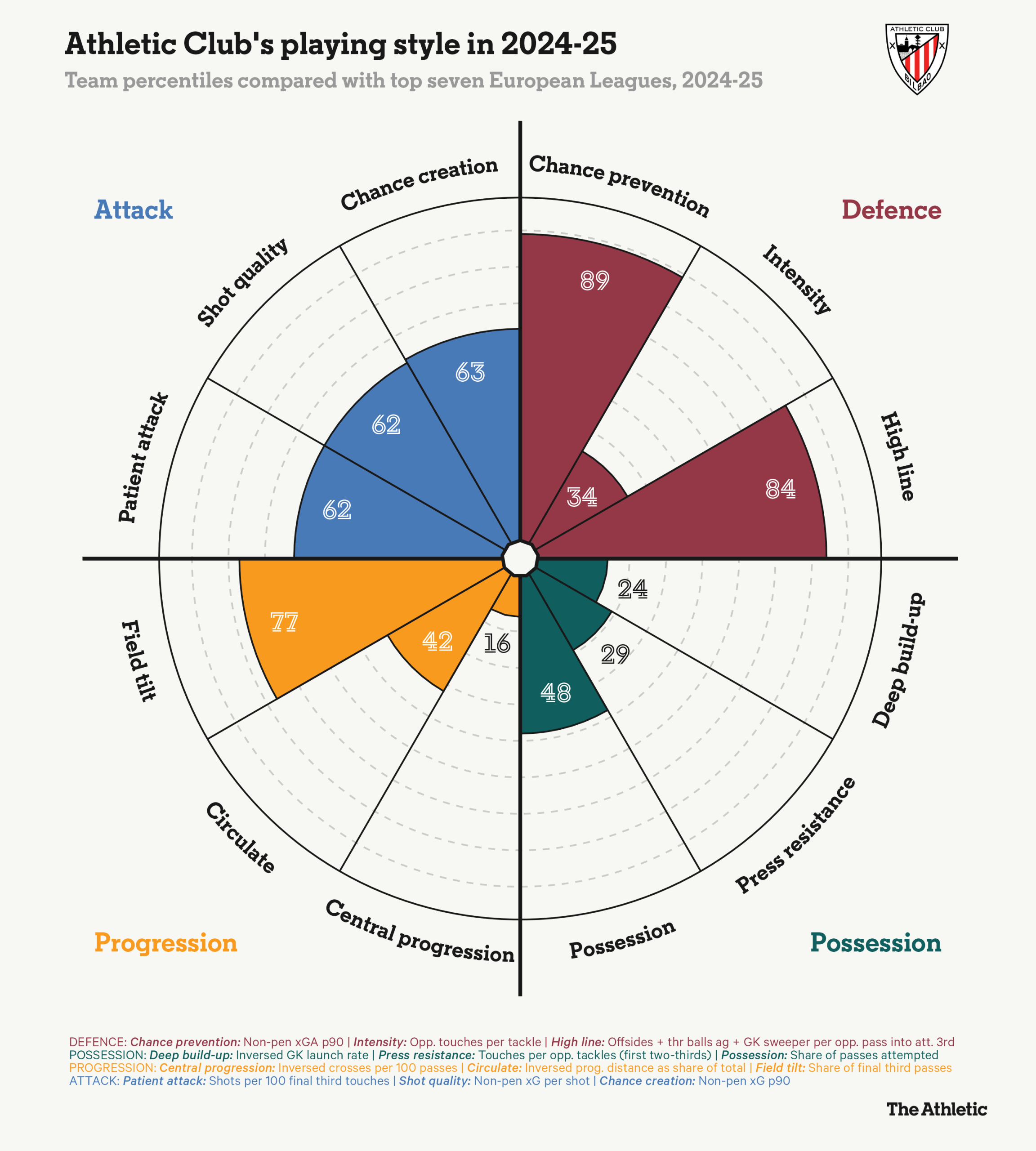
As Nico Williams leapt into his brother Inaki’s arms, it felt as if the stars were beginning to align. His back-post header, Athletic Club’s 41st shot of an attritional two-legged quarter-final, finally helped end spirited Rangers resistance.
Athletic are arguably as strong as they have ever been, with Ernesto Valverde thriving in his third spell in charge, an outstanding crop of academy graduates coming through, and one defeat and only four goals conceded in their last 10 games. Not only that, their upward trajectory coincides with the Europa League final — from which they are now two games away — being held at their iconic stadium.
Anyone who remembers the jubilant celebrations in the city of Bilbao this time last year, as the club paraded their first Copa del Rey trophy in 40 years down the river Nervion on their traditional ‘Gabarra’ barge, can begin to imagine how special an occasion a home final at San Mames would be.
La Gabarra. #UniqueInTheWorld 🏆 #AthleticClub 🦁 pic.twitter.com/7ISCI8ChnC
— Athletic Club (@Athletic_en) April 12, 2024
Manchester United stand in their way, and while Ruben Amorim’s side have the quality to spoil the party, they meet a side who are organised in defence, full-on in attack, and fuelled by the belief that with all that has fallen into place for them, it has to be their year.
This is what United can expect.
A good place to start is with The Athletic’s playstyle wheel, a tool that uses Opta data to compare various aspects of a club’s tactical approach with the 131 other teams in Europe’s top seven leagues.
Instantly, Athletic’s defensive solidity stands out, with a rating of 90 in the Chance Prevention metric indicating that they generally allow few goalscoring opportunities. No team across the continent have conceded fewer league goals at home (10), with only two more in the Europa League. They relish the big occasion in front of their fans, having beaten Barcelona, Real Madrid and Atletico Madrid at San Mames since the start of 2024.
Advertisement
Their Field Tilt score of 77 — a possession-style metric that helps to measure territorial dominance in the attacking third — also catches the eye, but while Athletic can dominate against weaker sides, they generally prefer a more even contest, where they can set up in their 4-4-2 defensive shape and contain the opposition, before hitting quickly and powerfully on the break.

The following passage of play from their recent 1-0 defeat away to Real Madrid — only undone by a stoppage-time volley from Federico Valverde — illustrates what makes Athletic’s mid-block difficult to break through.
Luka Modric drops deep to pick up the ball from his centre-backs, but the visitors are happy to sit off, remaining compact and denying any of Madrid’s central attackers space to receive the ball.
It is why Athletic rank poorly on our Intensity metric, as well as traditional pressing metrics such as PPDA (passes per defensive action), despite what looks to be stirring defensive commitment by eye. Their aggression is controlled, choosing their moments to go hunting for the ball, but otherwise happy to block the spaces and keep the opposition away from goal.
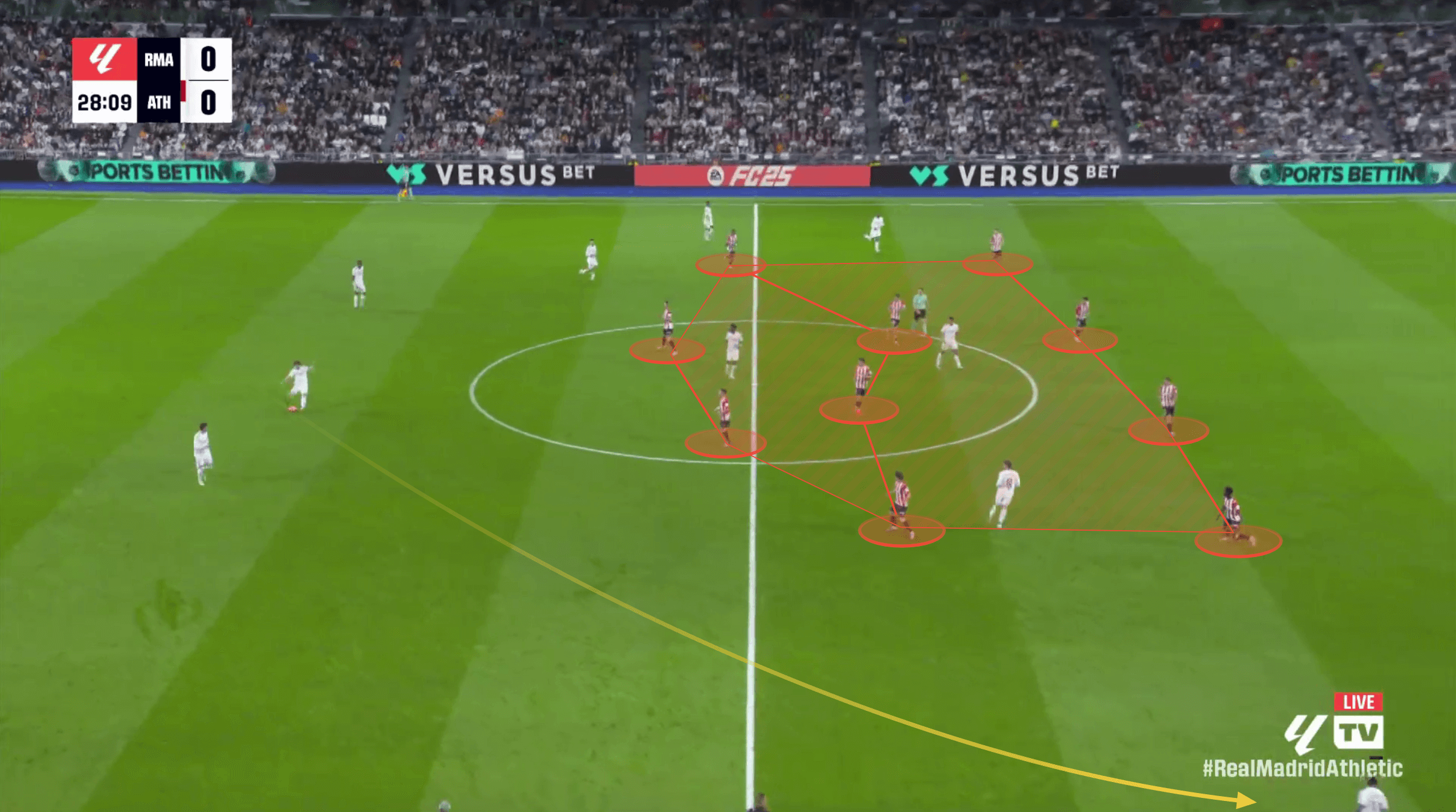
Athletic’s narrow shape leaves Rodrygo in space, but by the time the ball reaches the Brazil forward, Unai Gomez and Adama Boiro have closed him down, forcing him to go backwards.
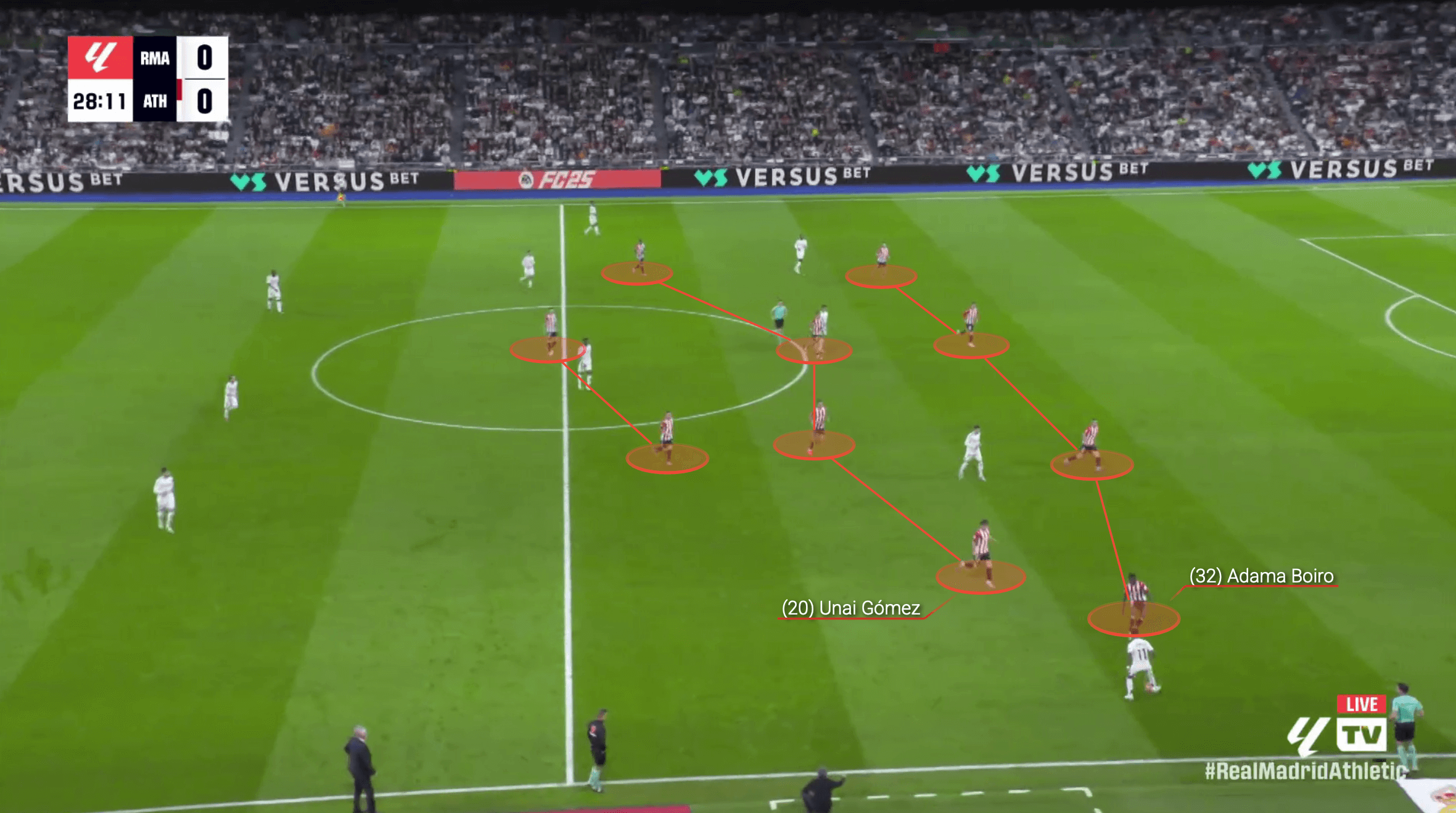
Possession makes its way back to Modric, with Athletic swiftly back into their compact, central shape. This time it is the centre-backs’ time to be alert, as Unai Nunez and Aitor Paredes drop to cover the run of Jude Bellingham through the middle.
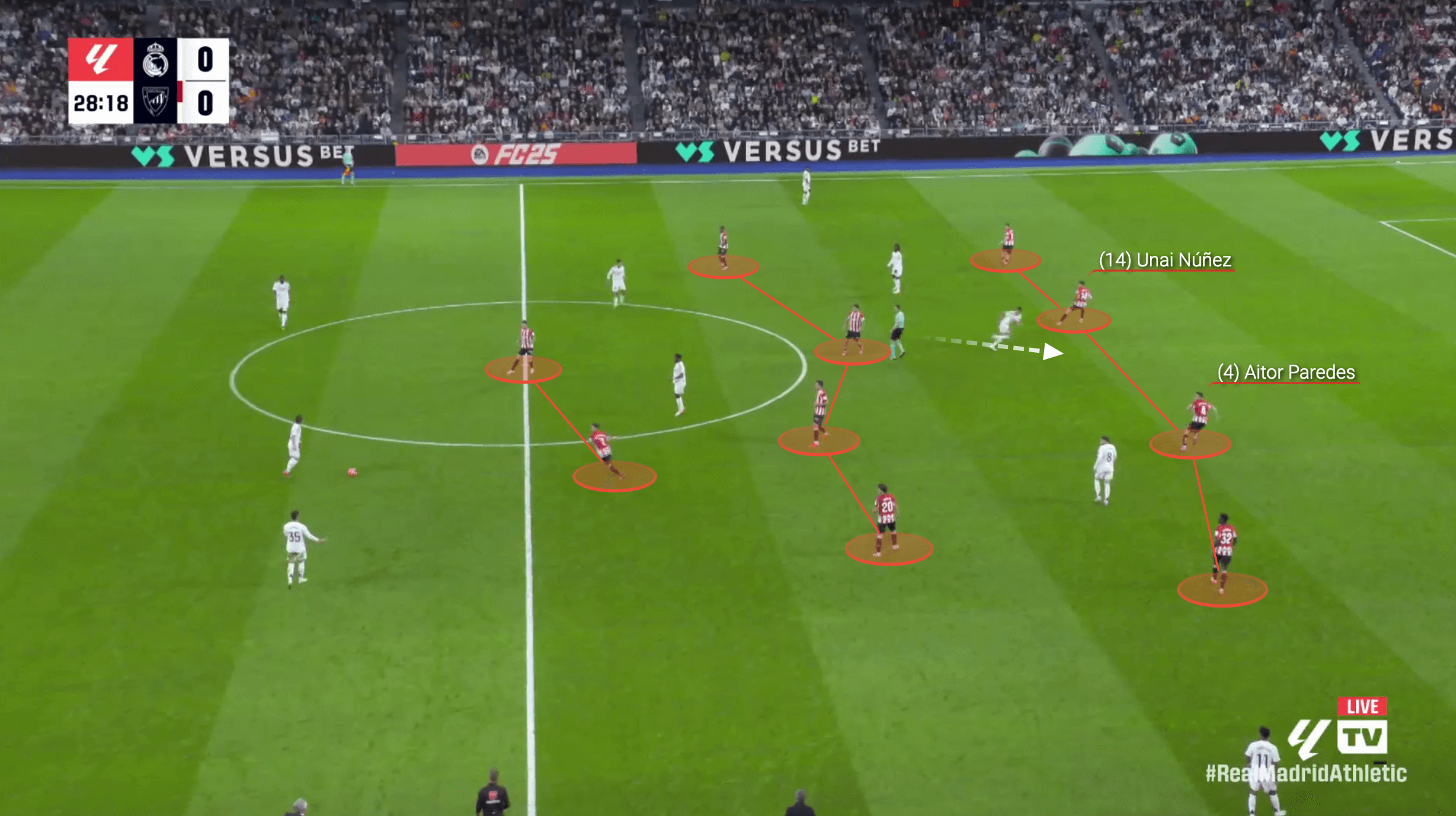
Madrid keep probing as Bellingham’s run is turned down, with Raul Asencio attempting to carry the ball into an advanced area. But he is closed down by Alex Berenguer, Mikel Vesga and Gomez on his way through, as all three eventually surround Rodrygo and send him backwards again.
It may not look spectacular, but the collective concentration for the whole team to shuffle from side to side, engaging and being aggressive at the right times, allows Athletic to control games without the ball.
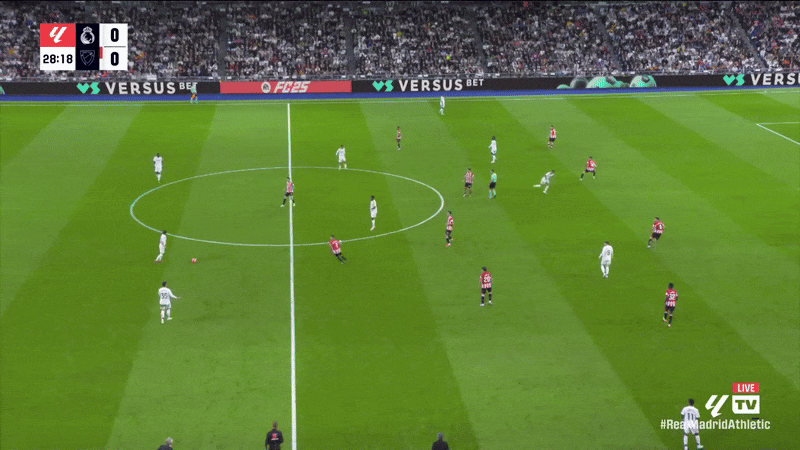
Still Madrid try to find a way through, finding Aurelien Tchouameni in a deep position, but this time it is Vesga who comes charging out of midfield to give the France midfielder a barge.
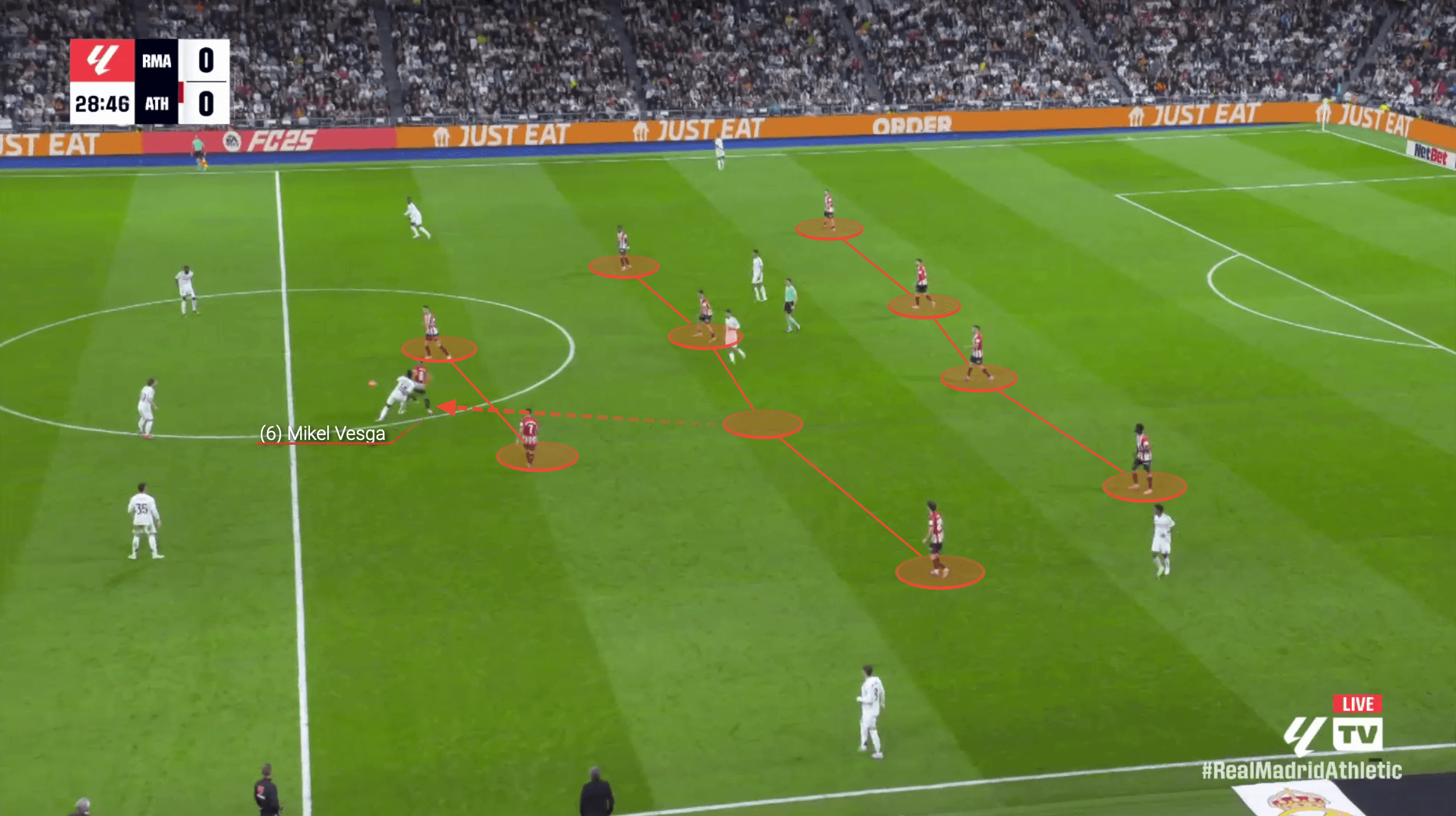
Finally, the ball is moved over to Eduardo Camavinga, who tries to find another Bellingham burst.
Athletic have again moved across as a unit, trapping Madrid by the touchline and keeping pressure on the ball, while the centre-backs have anticipated the movement and followed the run once more.
After more than two minutes of Madrid possession, the ball sails safely into the gloves of Unai Simon, without a single meaningful touch in the attacking third.
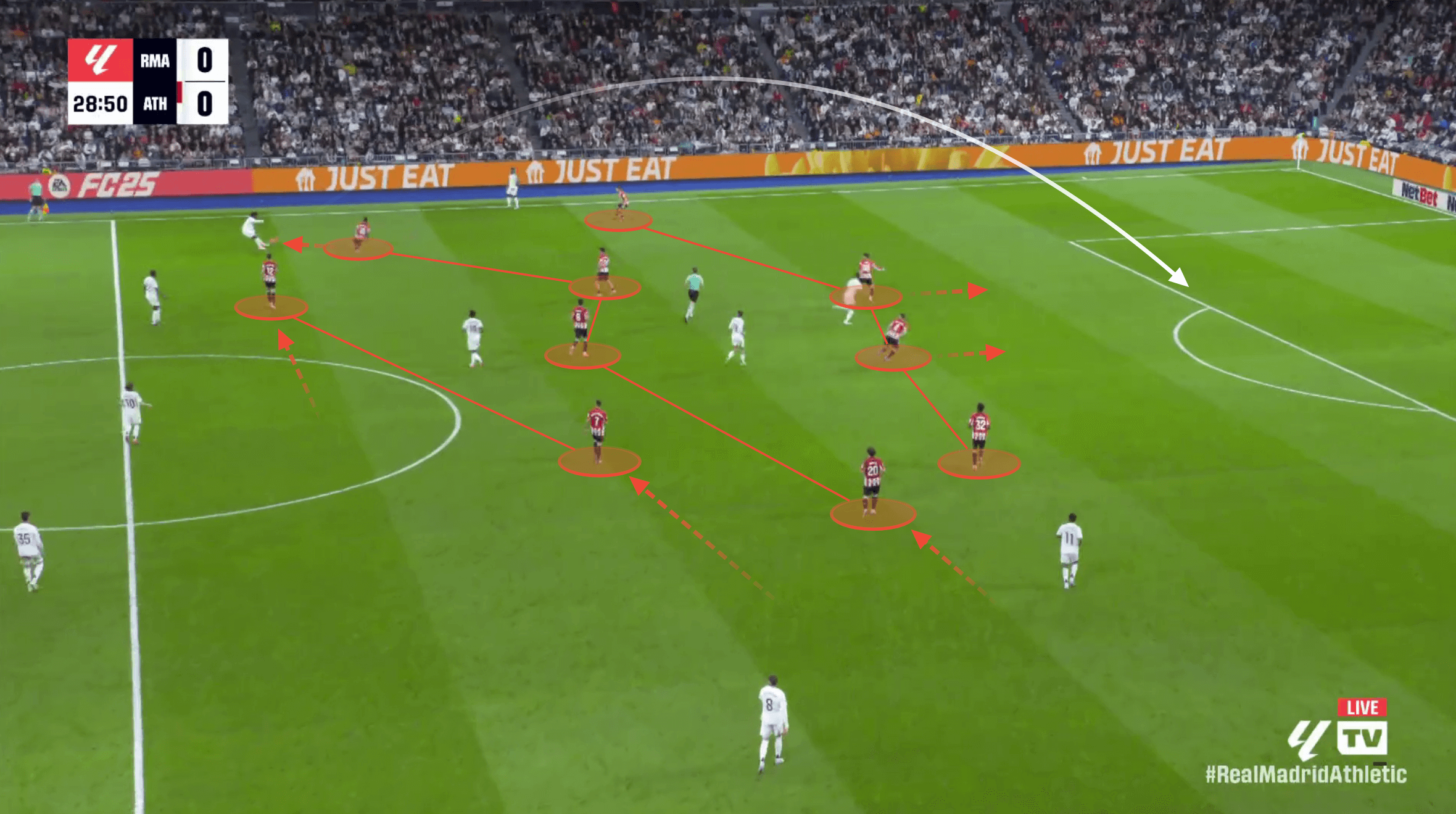
The key to such solidity is rooted in familiarity and continuity. Athletic made 10 changes for that trip to Madrid, but given the close relationship between the academy and the first team, and the time that they have played in such a way under Valverde, player roles are clearly defined.
Profiling throughout the squads remains intact too — dominant centre-backs who can win their aerial duels, snappy, ball-winning midfielders, and energetic pressers from the front — regardless of who plays.
Advertisement
Such trust in the system means that players know when they can take risks with their pressing, as we saw with Vesga above, and with fellow midfielder Mikel Jauregizar in the clip below.
The 21-year-old jumps out of the defensive shape to dispossess Rayo Vallecano midfielder Oscar Valentin, before laying off for Oihan Sancet to score. Only Barcelona have taken more shots after recovering the ball in the final third this season.
1⃣6⃣ tantos de @oihan_15 esta temporada.
🎩 ¡Vaya manera de firmar el gol 5⃣.0⃣0⃣0⃣ del #AthleticClub en @LaLiga! #AthleticRayo pic.twitter.com/tXRx3xDlGV
— Athletic Club (@AthleticClub) April 15, 2025
It often takes a moment of individual brilliance to get through Athletic’s focused, compact shape, but their tenacity means that you cannot dally on the ball, either.
Defensive strength is not the only benefit of a consistent, rigorous 4-4-2 shape — it allows for easy, quick transitions into attack.
Athletic like to be direct with the ball at their feet, and have simple patterns when it comes to moving quickly up the pitch. The wide players career down the flanks, the striker rushes in behind, while a deeper midfielder joins the No 10 to arrive late.
It means there is little hesitation to spring forward when Athletic turn over the ball, as we can see below against Leganes.
Jauregizar is again the player to nick possession, allowing Berenguer to take over. Straight away, both wingers have their heads down, while Vesga busts a lung to get forward from further back.
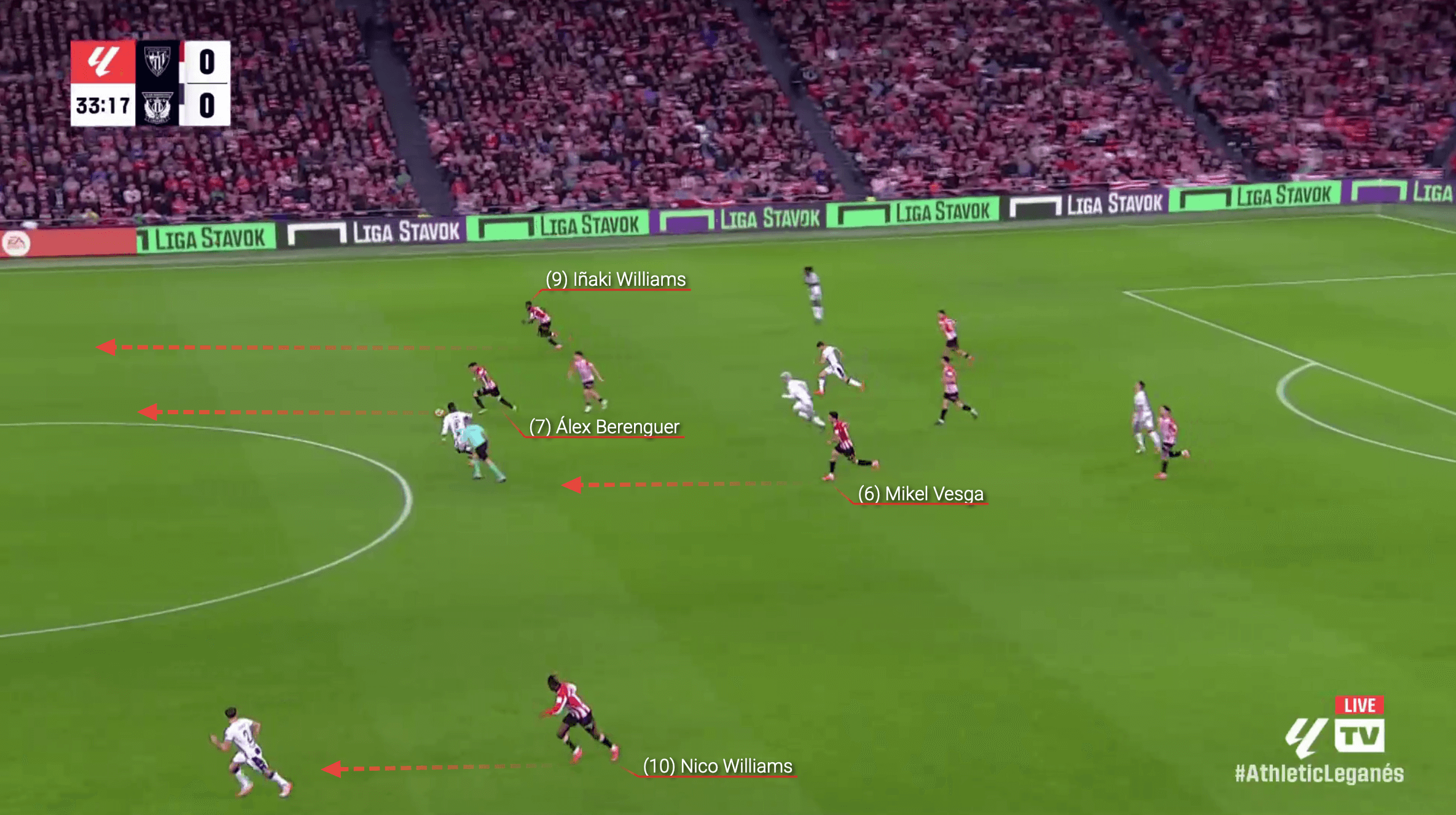
Within eight seconds, Athletic have five players in the opposition penalty area.
Inaki Williams makes a poor choice and opts to shoot — the team aren’t always the most clinical in such situations — but the potential to race down the pitch and find a killer cut-back or through ball is always there.
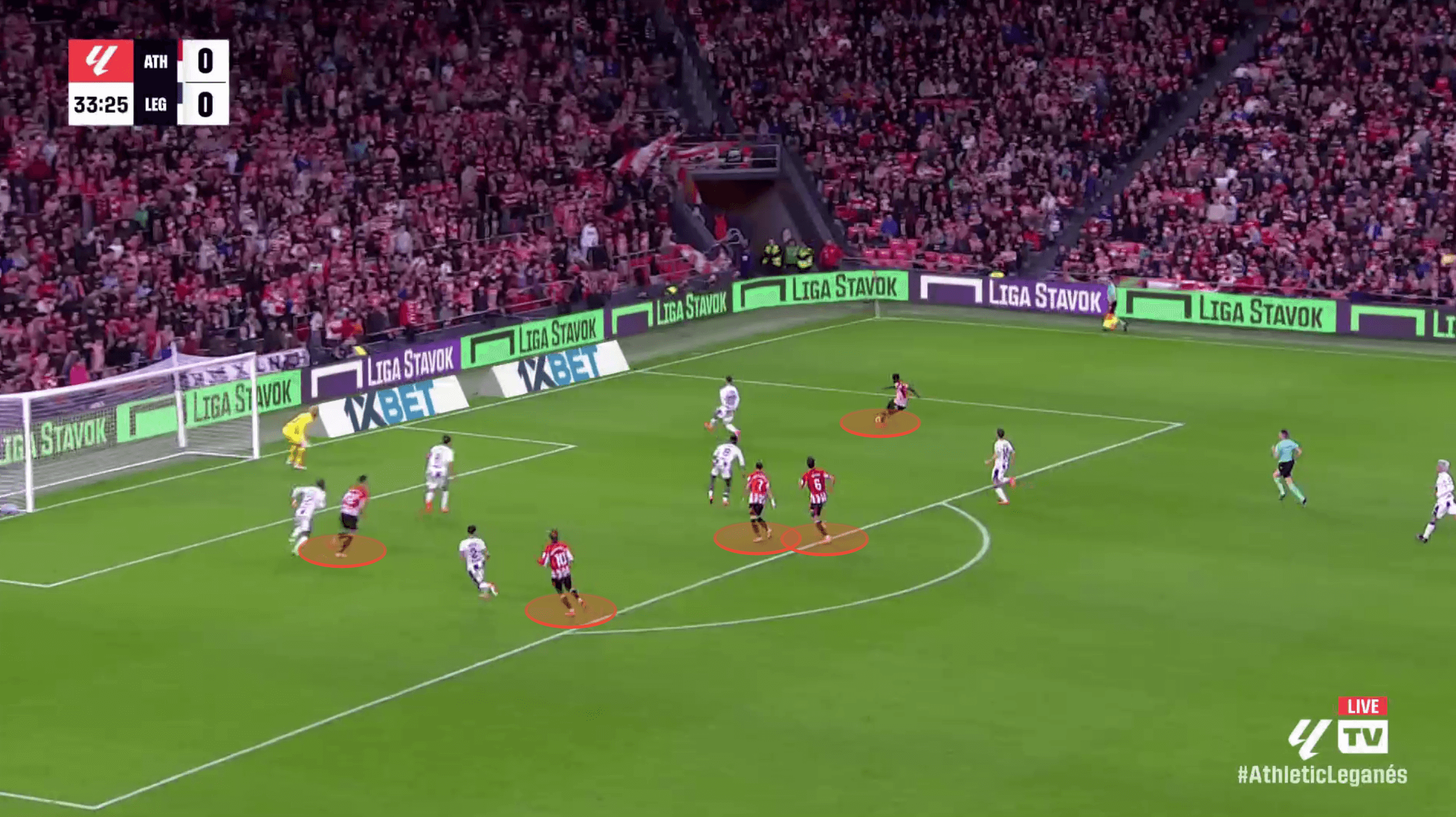
Such eagerness to move the ball quickly towards goal is captured by the numbers, with Athletic clear outliers in La Liga for the share of their passes and dribbles that are progressive. Only Andoni Iraola’s rampant Bournemouth side can match their positivity on the ball across Europe’s big four leagues.
Give them space to attack, and Valverde’s team rarely turn down the chance.
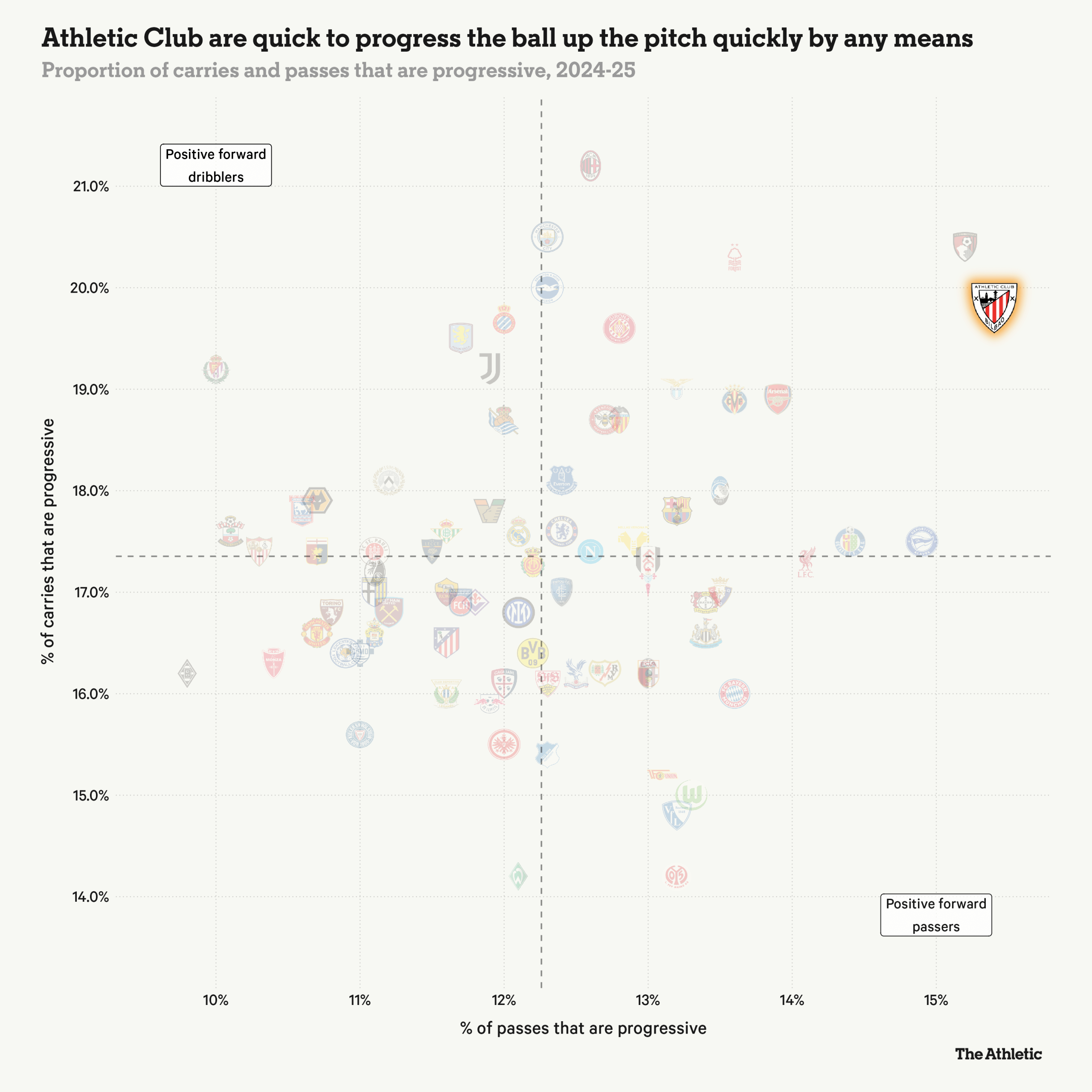
On an individual level, destructive midfielder Inigo Ruiz de Galarreta stands out for his ambitious distribution. According to data from SkillCorner, only six La Liga players have broken the last line of defence with passes more frequently this season, often searching for floated passes over the top.
Advertisement
Here against Real Betis, after Nico Williams runs into a blind alley down the left, possession is recycled to Galarreta. The pass into him often acts as a trigger for runs in behind, with four players making an effort to get into the box as the midfielder turns out and faces play.
In the end, he picks out Benat Prados with a reverse pass, who almost redirects it into the onrushing Berenguer.
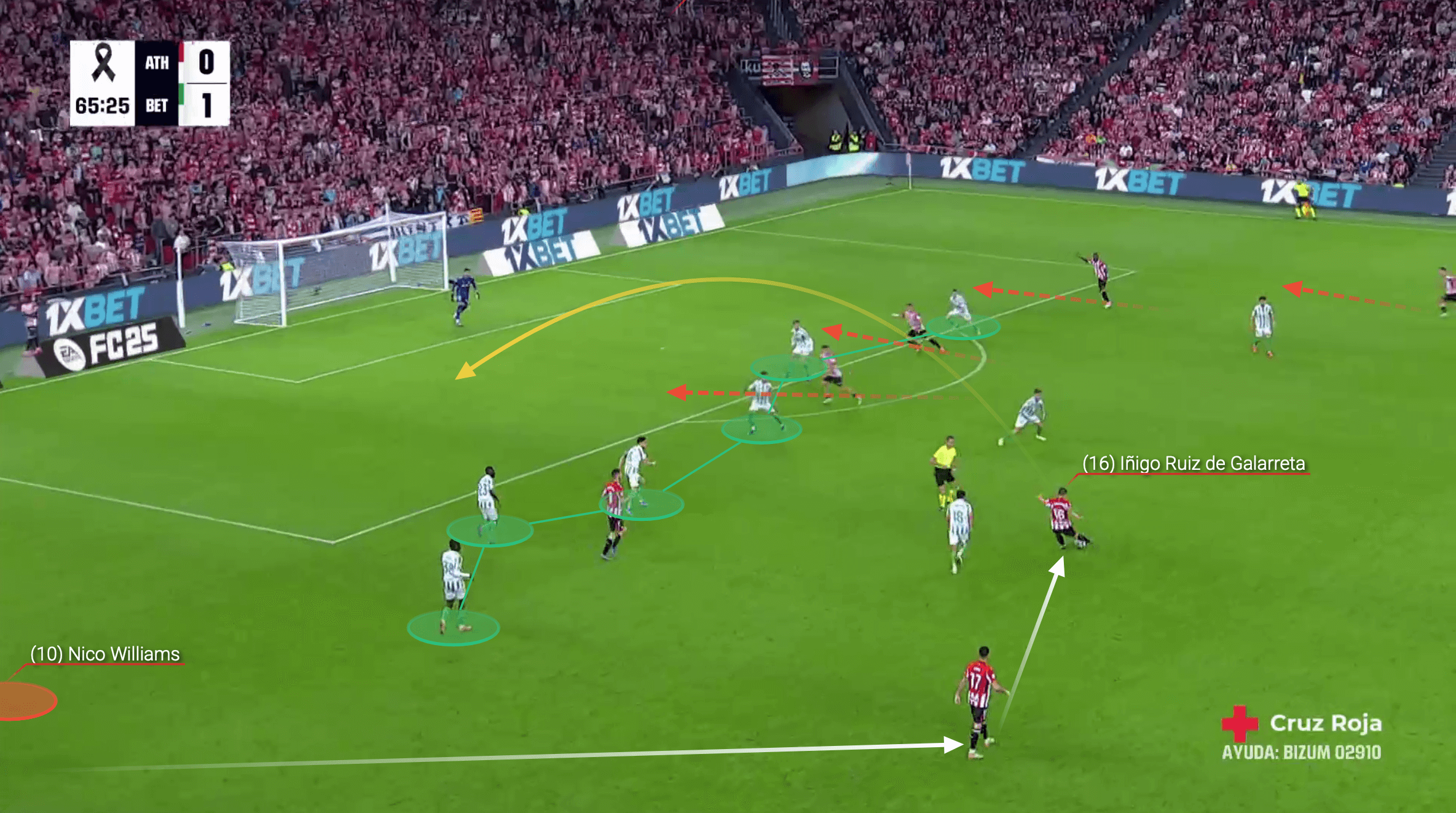
Nico Williams is the dribbling outlet, one of only four players across Europe to average more than eight take-on attempts per 90 in this campaign.
After a quieter start to the season, the 22-year-old has burst into life in the Europa League, with two expertly taken goals and a curling shot that crashed off the post against Roma in the round of 16. His quick feet and ability to drive to the byline and cut inside — as illustrated below — makes him a constant threat out on the left.
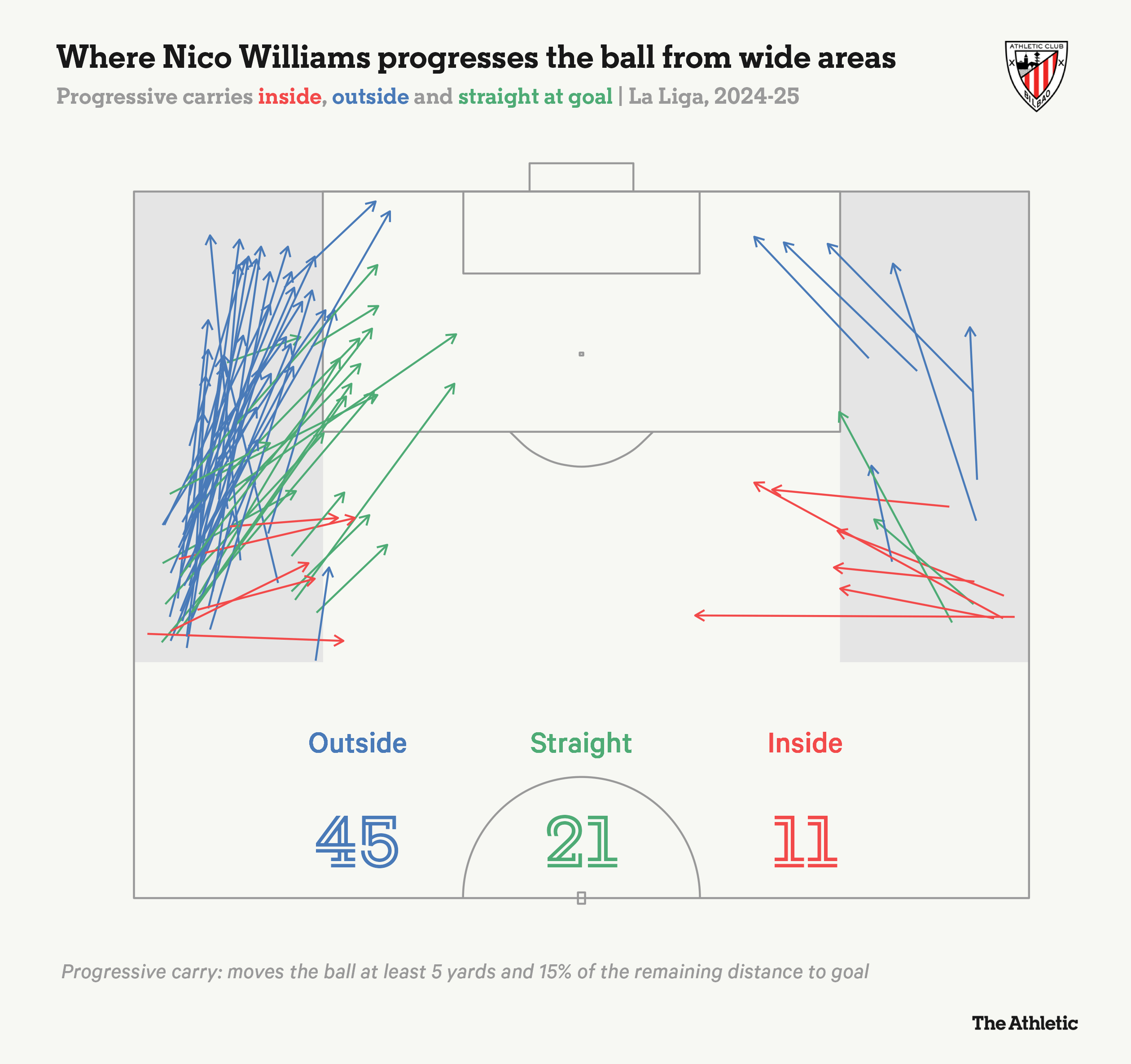
The star of the show in attack, however, is elusive attacking midfielder Sancet, with 17 goals in 2024-25, more than his previous two seasons combined.
Sancet is tall, strong, and combative, able to stride confidently with the ball at his feet and similarly driven and forward-thinking in his passing. But it’s around the penalty area that he has come to life; timing his runs to meet cut-backs, getting on the end of crosses, and making good contact on either foot to finish from distance.
That ball-striking ability is driving significant over-performance in front of goal, detailed by his season shot map, with a thumping volley against Valladolid and a sweeping finish into the far corner at Rayo Vallecano shining examples of his technique.
Sancet has been ruled out of the first leg at San Mames with a hamstring problem, likely to be replaced by the lively Berenguer, but the 25-year-old could yet have his say on the return to Manchester.
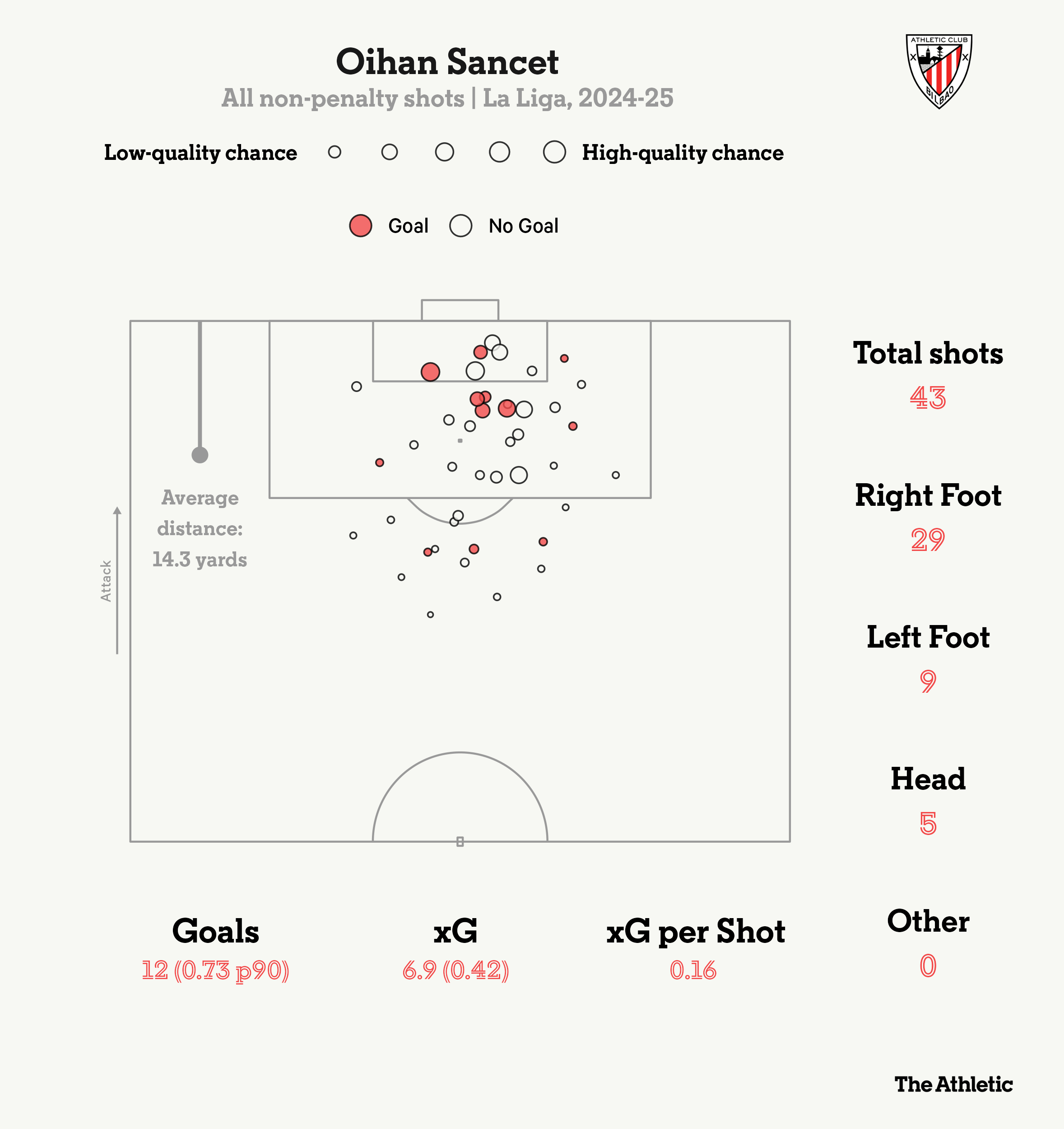
Athletic are an honest, traditional club — their famous policy of only using players born in the Basque Country is unique throughout European football — and their style of play reflects that.
They are rarely intricate or overelaborate, but with an uncomplicated approach and commitment to repeatable, tried-and-tested patterns, they have consistently punched above their weight.
Now, with an exciting new generation of players — Jauregizar, Boiro, and back-up keeper Julen Agirrezabala following only a few years after Nico Williams, Sancet and Dani Vivian — there is real hope that history can be made.
(Top photo: ANDER GILLENEA/AFP via Getty Images)
This news was originally published on this post .




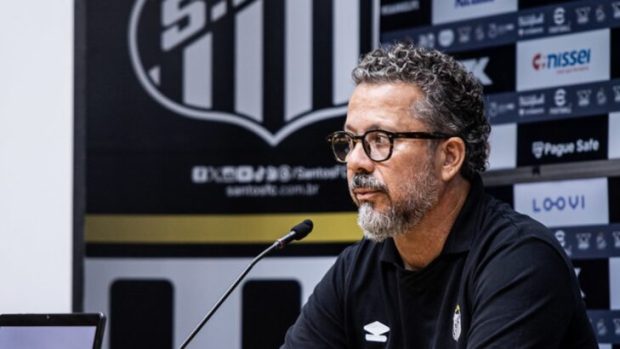



Be the first to leave a comment